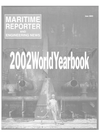
Prospects Abound, But Where's the Money?
While the U.S. commercial shipbuilding industry outperformed the U.S. economy between 1992 and 2001, this period witnessed the construction of barely a dozen large ocean going vessels for our U.S. domestic trades with an aggregate cost of not much more than $500 million. In contrast, U. S. national transportation needs for the current decade will require the construction of four to five dozen such commercial vessels which, taken together with the building of smaller vessels to meet our other domestic needs, will involve shipbuilding contracts in excess of $6 to $7 billion.
The majority of this work is federally mandated by the Oil Pollution Act of 1990, or involves the replacement of vessels in our U.S. non-contiguous trades that have reached the end of their useful lives. The balance is driven by U.S. population growth and environmental concerns that are not likely to abate.
These U.S. national transportation needs are clear and immediate. However, the means for financing the vessels to meet these needs remains uncertain. During the last such period of major U.S. shipbuilding activity two important federal government assistance programs administered by the U.S. Maritime Administration (MarAd) under Title VI and Title XI of the Merchant Marine Act of 1970 (the 1970 Act) were employed to meet vessel financing needs. To date, in this decade, there has been only limited recourse to these two potentially important financing programs.
And, the Bush Administration Office of Management and Budget (OMB) has apparently targeted both of these programs for termination. What conclusions can we draw concerning U.S. shipbuilding to meet our U.S. national transportation needs for the current decade?
The U.S. Shipbuilding Scene: Vessel Needs The Jones Act and the Passenger Vessel Services Act reserve the carriage of cargo and passengers between U.S.
ports to vessels built in the United States, operated under U.S. registry and owned and operated by U.S. citizens.
These Acts protect U.S. shipbuilders from competition by foreign shipyards and provide a relatively stable maritime investment opportunity. While the world shipbuilding market is such that U.S.
shipbuilding opportunities are limited to the U.S. domestic trades, there are well documented, existing and near-term transportation needs which will provide significant building opportunities for U.S. commercial shipbuilders. The most important opportunities are those which result from the Oil Pollution Act of 1990 and the needs for double hulled vessels in our U.S. coastwise and Gulf of Mexico energy related services. These and other petroleum related requirements should provide varieties of employment which will bridge the entire spectrum of shipyard size. Supplementing this work, and of equal importance for our larger shipyards, are the ocean-going container and RoRo tonnage fleet replacements needed for our non-contiguous services, and perhaps for the initiation of coastwise feeder operations. Smaller yards should find ample supplemental employment in producing a wide variety of vessels, with perhaps the single most important subject matter being the vessels for expanding passenger and passenger/ vehicle ferry services.
Other stories from June 2002 issue
Content
- Bollinger To Acquire Halter Marine page: 6
- Bidding War Comes to an End page: 6
- Jotun And NOF Marine Coatings Join Forces page: 8
- Thunder Horse Will Get Wartsila Generators page: 10
- United Defense to Acquire United States Marine Repair page: 10
- New Order For MAN B&W Diesel ME-Engines page: 12
- Fares Al Salam Parts The Red Sea page: 14
- Redundancy The Next Watchword? page: 20
- Cargo Handling's New Force page: 22
- A Naval Architect's Look At Design Trends page: 24
- Conoco Leads The Way For GOM Shuttle Tankers page: 27
- Daewoo Shipbuilding To Build, Refit LNGs For Exmar page: 27
- Navy League Comes to NY for Centennial Celebration page: 28
- Prospects Abound, But Where's the Money? page: 32
- OPA '90 - The Oil Pollution Act of 1990 page: 33
- Container & RoRo Tonnage — Non-Contiguous Liner Trades page: 35
- Matson Signs $220M Contract With Kvaerner Philadelphia page: 38
- GL: Exporting German Precision page: 40
- World Shipbuilding to Fall Slightly page: 44
- Tanker Market is Solid page: 45
- Bergesen Releases 1Q Results page: 46
- OMI Announces 1Q Results page: 47
- MAN B&W Turbocharger Technology Unveiled page: 49
- Answering the Call from Above page: 50
- Thrane & Thrane Offers Capsat Fleet77 page: 53
- Crisis Management and the Integration of Vessel Tracking Technologies page: 60
- Rear Admiral Pluta Redefines Maritime Security page: 64
- Ship Graveyard page: 68
- Intertanko's Sustainable Challenge page: 72
- German Barging: Over the Divide page: 76
- Blohm+Voss: 125 Years Young page: 80
- Thordon Makes Inroads With COMPAC Shaft Bearing page: 90
- Halifax Lays Keel For First of Two OSV's page: 91
- Owners Approve White Rose Oilfield page: 91
- Voyage Data Recorders page: 92
- Titan Re-Floats IMaersk La Guaira page: 96
- Austal USA Enters Repair Market page: 96
- Maritime Industry Remembers Nealis page: 97

